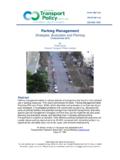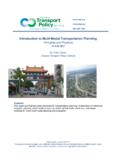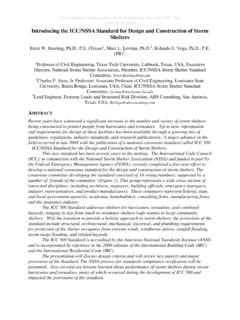Transcription of Evacuation Station: The use of Public …
1 ITE Journal on ThE wEb / January 2008 69By MICHAEL A. SCHWARTZ AND TODD A. LITMANTHIS f EATuRE ExAMINES EMERgENCy TRANSpORTATION pLANNINg pRACTICES AND THE ROLE THAT Public TRANSIT CAN p LA y. WHILE pu BLIC TRANSpORTATION OfTEN IS u SED IN EMERgENCy SIT uATIONS, THERE IS RARELy pLANNINg OR COORDINATION, LEADINg TO CONfu SION, INEff ICIENCy AND RISk. RECOMMENDATIONS pRO vIDED IN THIS f EATuRE CAN HELp TRANSpORTATION pRO fESSIONALS BETTER pRE pARE f OR Station: The use of Public Transportation in Emergency Management Planning Hope for the best but prepare for the worst. INTRODuCTIONIn the fall of 2005, two major hur-ricanes Katrina and Rita rocked the Gulf Coast of the United States, requiring mass evacuations and other emergency transportation This experience indicated serious shortcomings in current emergency transportation planning and management.
2 In New Orleans, LA, USA, many peo-ple were unable to flee the city as instructed because they lacked transportation. After Hurricane Katrina hit, there were severe problems evacuating victims and deliver-ing emergency supplies and services. In Houston, TX, USA, fuel shortages and excessive traffic congestion created sig-nificant delay, frustration and risk dur-ing Evacuation . In both cities, inadequate emergency transportation planning and service coordination reduced efficiency and contributed to avoidable professional guidance re-sults in mistakes being overlooked and repeated. For example, in 2002, New Or-leans transportation engineers and Public officials were aware that many residents lacked Evacuation transportation, but little was done to address this gap, resulting in severe problems beginning with Hurricane Ivan in 2004 and then during Hurricane Katrina in New Orleans officials failed to implement transit agency policies to deploy buses to help evacuate non-drivers from the city and protect equipment from Similarly, many of the problems en-countered in 1999 during the evacua-tion of South Carolina before Hurricane Floyd were repeated in 2005 during the Houston area Evacuation .
3 Hurricane Rita revealed a lack of coordination within the city of Houston s emergency management plan, which designates the Metropolitan Transit Authority of Harris County, TX, as having primary responsibility for trans-portation in the event of an emergency, but designates the police as having pri-mary responsibility in an Prior to Hurricane Rita, there was uncertainty as to whether the mayor had called for an Evacuation or merely a mobilization of residents in higher-risk areas. This reflected an unclear chain of command, resulting in inadequate coor-dination among agencies. These are just a few examples of emergency transportation planning failures that caused avoidable confusion, delay and is important for transportation profes-sionals to learn from these mistakes.
4 Effective management of transportation resources is essential during emergencies. Transit agen-cies are in the unique position to efficiently provide emergency services to people who lack transport options because agencies al-ready have most of the required resources. Proper planning and coordination can pre-vent many problems and save feature examines current emer-gency response transportation planning, particularly the role of Public transit ser-vices in Evacuation . It summarizes a survey of emergency transport planning practices in major cities and provides recom-mendations for improving transportation services in emergencies. It is hoped that this information will help stimulate reflection, planning and action on these critical issues by transportation LITERATuREAlthough most people likely would agree that transportation is an essential emergency service, relatively little research or practical guidance exists for emergency transport man-70 ITE Journal on ThE wEb / January 2008agement, particularly regarding the provision of Evacuation services for non-drivers.
5 Scanlon found that although it appears Public and specialized transit often plays an important role in emergency response, both the disaster literature and case stud-ies tend to skim over that. There appears to be no definitive material showing how this fits into planning and response and how problems are dealt with. 5 Similarly, Evacuation of people without a vehicle is an area which has been largely unaddressed by Department of Transportation officials planning for Evacuation . 6 Scanlon provides numerous case stud-ies involving specialized and Public tran-sit s successful involvement in emergency situations, particularly These examples indicate a lack of planning and coordination. Many officials minimize the importance of planning for emergencies, apparently assuming that such events are too unpredictable to allow specific preparation.
6 As one Washington, DC, USA, city official explained, It is highly unlikely that city of-ficials would evacuate the entire city. However, Wachtendorf and Quaran-telli point out that while improvisational leadership was essential in the Evacuation of lower Manhattan, NY, USA, on Sep-tember 11, 2001, it should inspire agen-cies to research and pre-plan for emer-gency events because better preparation can increase the possibility of A survey of more than 90 transit agen-cies by the Transportation Research Board found that 32 percent of systems were concerned that Public transportation may not be fully used as an Evacuation system (in comparison to reliance on automo-biles). 9 The lack of formal guidelines and best practices diminishes transit agen-cies ability to respond effectively during emergencies.
7 The survey found that many systems have thought about emergency operations (90 percent) and have plans in place (66 percent).10 However, fewer of these agencies (57 percent) have plans that coordinate with others outside the system. Similarly, only 36 percent of the systems that pro-vide only bus transportation conduct regular emergency operations training; 52 percent report that they have not run a drill in the last six months; and 40 percent report that they have not trained all personnel according to their responsibilities on how to respond to pLAN EvALuATION METHODOLOgyTo evaluate current emergency trans-portation planning practices, the informa-tion provided on emergency transpor-tation at emergency management and transit agency Web sites in major cities was surveyed.
8 The peer selection function on the Inte-grated National Transit Database Analysis System program software, which manipu-lates data from the National Transit Data-base, was utilized to select case cities and agencies. The 10 largest agencies (rail and bus) were selected based on the number of unlinked passenger trips in 2002 (the most recent year with available data). These peers attempt to account for the size of the system and overall utilization. Another set of 10 peer systems was se-lected based on the number of unlinked passenger trips per service area capita in 2001 (full data on this measure were not available for 2002). This was intended to account for transit usage and depen-dence.
9 In addition, four Florida transit agencies were selected from the largest cities outside Miami, FL, USA. This selection was to ac-count for cities that might be more experi-enced in Evacuation (due to the frequency of hurricanes in Florida) to determine if this was influential in incorporating transit into their plans. Table 1 shows the resulting transit agencies and their related Agency Web Site EvaluationTransit agency Web sites were searched for answers to the following two questions:1. Is there an emergency Evacuation plan addressed on the transit Web site? This could include emergency Evacuation from transit vehicles or from the city. This question is designed to address whether the agency is emergency-con-scious.
10 Does it prioritize emergency safety and/or recognize its role in emergency management?2. Does the Web site refer to emergency management agencies? These could include local, state, or federal agencies. This question measures the strength of relationship between the transit agency and the emergency manage-ment agency or department. Corresponding City Emergency Management Web Site, Plan and Public Interface Evaluation To answer the following questions, Internet-based research was conducted. First, the office/department of emergency management Web site for the correspond-ing primary city of each transit agency was New York City Transit (NYC Transit): New York, NY, USA Chicago Transit Authority (CTA): Chicago, IL, USA Los Angeles Metropolitan Transportation Corporation (LAMTC): Los Angeles, CA, USA Washington Metropolitan Area Transit Authority (WMATA): Washington, DC, USA Massachusetts Bay Transportation Authority (MBTA): Boston, MA, USA Southeastern Pennsylvania Transportation Authority (SEPTA): Philadelphia, PA, USA San Francisco Municipal Railway (MUNI): San Francisco, CA, USA New Jersey Transit Corporation (NJ Transit).










